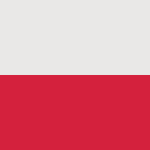The history of Poland
The Piast kings 960 – 1370
“Modern” (= Christian) Poland can be reckoned from around 960 AD. The borders back then were probably very close to the borders we know today, but the country was certainly not a solidified entity. Borders were constantly changing and the “Poland” of that time was inhabited by different peoples. The first royal family was the Piast dynasty, which accepted Christianity around 960. This led to the country being recognised by Germany and various other groups who saw pagan nations as something that could be freely attacked. Around the turn of the millennium, some of the most significant Polish cities were founded, including Wroclaw, Gdansk and Krakow. The recognition of Christianity and an effective foreign policy towards Germany led to the Pope recognising Boleslaw I of the Piast dynasty in 1025 and accepting the title ‘king’.
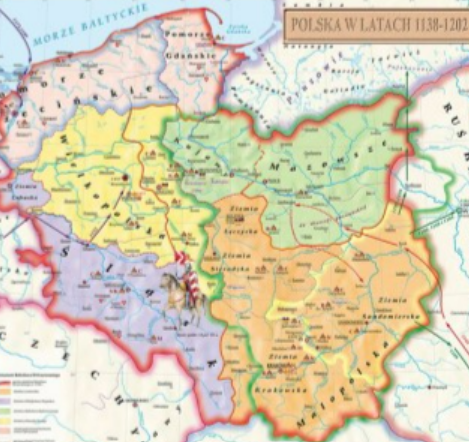
Division of Poland from 1138, Teutonic Knights and Mongol invasions
After the death of Boleswaw III in 1138, Poland was divided into several duchies so that each son could have his own country. Theoretically, the Grand Duke of Cracow was supreme compared to the other dukes, but the centralised power was very weak during this period. The internal strife played an important role in allowing the Teutonic Knights to establish a kind of state in the Baltic Sea region. And presumably the lack of a centralised power also made it easier for the Mongols, who ravaged the country in 1241-42. It’s a period of upheaval in Europe, with different nations struggling to define their borders and the German lands expanding eastwards. During this period, the first displaced Jews also came to Poland from Western Europe.
Reunited Poland opens the first university
In 1320, Wladyslaw the Short united Poland under his leadership and halted the expansion of the Teutonic Knights. His son, Kazimirz the Great (1333-70), reformed Poland. He ensured a strong royal power, realised huge building projects and founded the University of Krakow in 1346.
Kazimirz the Great does not get a heir – Louis of Hungary becomes king
In 1370, Kazimirz the Great died without leaving a legitimate son. This led to a series of internal disputes in Poland before the throne was taken over by Kazimir’s relative, King Louis of Hungary. This led to a short-lived personal union between Poland and Hungary, which is, however, very present in the Polish consciousness. Louis of Hungary died in 1384, after which his 10-year-old daughter, Jadwiga became Queen of Poland.
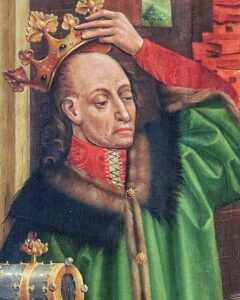
Wladysław Jagiełło (c. 1351-1434)
Jagiellonian dynasty 1386 – 1572. Personal union with Lithuania
Jadwiga quickly married the Grand Duke of Lithuania, Wladyslaw Jagiello, who became King of Poland in 1386. The couple founded the Jagiellonski dynasty, which ruled Poland for the next 200 years. The main political consequence of the marriage was that Poland and Lithuania entered into a personal union. At the time, Lithuania was a major power ruling over large areas in what is now Belarus and Ukraine. The marriage agreement stated, that Wladyslaw had to give up paganism and become a Christian. This in turn gave less pressure from the Teutonic Order, who saw it as their mission to fight paganism, and this military threat may have been crucial to the new alliance.
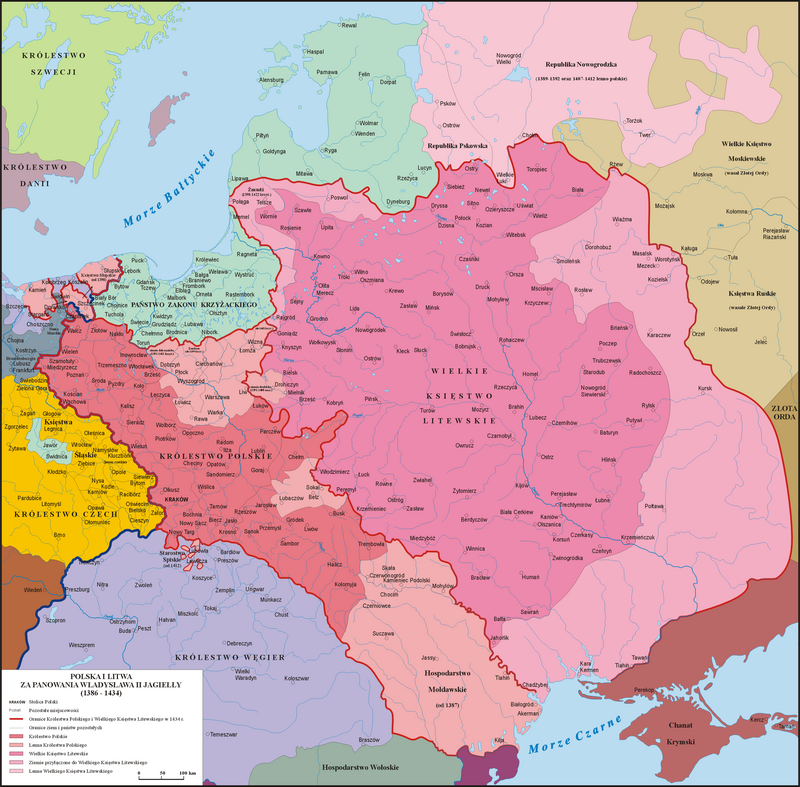
Poland-Lithuania 1386 from the Baltic to the Black Sea
The Battle of Grunwald in 1410 between Poland and the teutonic knights
Poland-Lithuania was in constant border disputes with the Teutonic Knights. The Battle of Grunwald in 1410 is a decisive battle in both German and Polish consciousness, where the Order suffers a decisive defeat, but continues as a significant power by the Baltic Sea. In 1466, Poland succeeded in acquiring Gdansk and thus access to the Baltic Sea. Access to the Baltic Sea and international trade is probably one of the main reasons why Poland will see huge revenues from the grain trade for the next few hundred years. The nobility tightens control over the peasants and expands with huge farms to the East. The main customers are the Netherlands and England, which during this period make the first steps towards overseas expansion while farmers are given more freedom. In Poland, the noble parliament, the Sejm, has a significant influence on state governance, and over the next 100 years, a sharply divided society of nobility, clergy, peasants, Jews and citizens emerges, each with their own distinct laws, rules and rights.
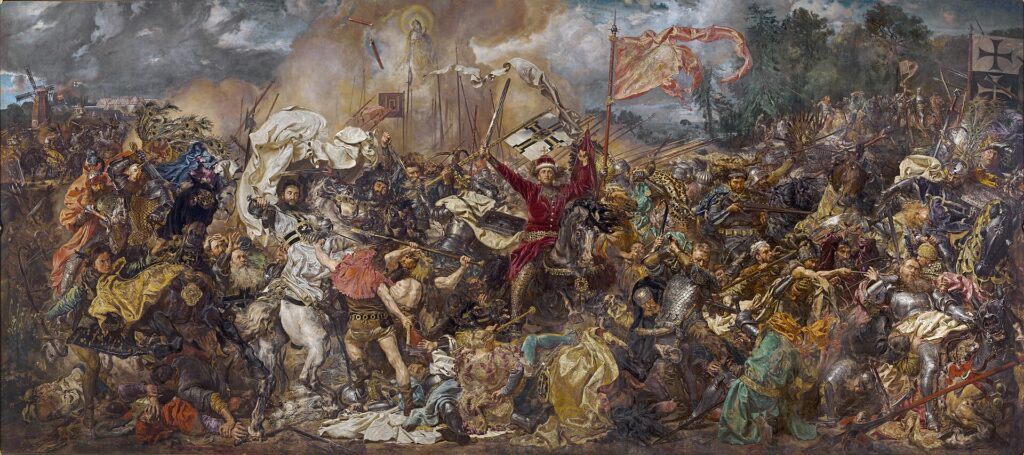
The Battle of Grunwald in 1410, here in an interpretation by Poland’s national painter, Jan Matejko in a large-format painting from 1878. The image measures 426×987 cm. and the original can be seen at the National Museum in Warsaw.
1505 Nihil Novo = Nothing New = No new taxes
In 1505, the king accepted the charter “Nihil Novi”, in which he committed himself not to change the organisation of society without the consent of the nobility. The Charter was referred to in common noble parlance as “Nothing about us, without us”, and this phrase is still quoted today when political forces believe their rights are being suppressed.
Please click on the picture or the headline to continue
Moscow grows and the Reformation rages
Meanwhile, Moscow emerged as a regional power in the east, thereby halting Lithuanian expansion. The next few hundred years would be characterised by the power struggle between Moscow, Warsaw and Sweden.
Around 1520, the Reformation came to the region. As a result, the Teutonic Order collapsed and formed the secular state of Prussia, while Poland further expanded into the Baltic Sea region.
Liberum Veto and real union with Lithuania. 1572– 1795
in 1569, The childless King Zygmunt II August forced the Lublin Union, which changed Lithuania-Poland from a personal union to a real union. The purpose was to avoid the collapse of the union when the king died. This was particularly important because there were significant tensions between both the expanding Russian state and Sweden. These conflicts later developed into a conflict for supremacy in the region and simultaneously a conflict between Protestantism, Catholicism and Russian Orthodox Christianity.
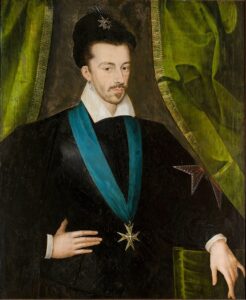
Henryk Valois (in Polish: Henryk Walezy) was the first Polish election king. However, when his brother died, he left Poland to become King of France.
The nobility introduces elective kings
After the death of Zygmunt II August in 1572, Poland-Lithuania established a noble republic with electoral kings. Parliament was divided into a bicameral system, with a Senate for the high nobility and a Sejm to which the nobility of the different regions sent their representatives. The union consisted of large territories in what is now Ukraine and Belarus, with many different peoples and widespread autonomy for local areas. The nobility made up around 10% of a population of 8 million, and it was the nobility that held all the power in the country. The union was governed from Krakow and Warsaw, and Poland was also considered the big brother in the relationship. Many Lithuanians today see the union as an annexation of their national territory and view the historical ties with some bitterness, while in Ukraine and Belarus, Polish expansion is often seen as a form of colonialism.
They really want a royal family, but never succeed
Although the idea of the electoral kings was to give the nobility the decisive influence, it was from the very beginning attempted to introduce dynasties, which was undoubtedly the reason for the election of a French royal child as the first king. However, the French Henry of Valois ran away in 1574 after only one year as Polish king, when he was given the opportunity to become King of France instead.
Decentralizing power while the kings became puppet kings
The next 200 years were characterised by a less than solid state structure, while there was an ongoing struggle for supremacy in Northern and Eastern Europe. The high nobility steadily gained more and more power and often co-operated with foreign powers. The election method was, that the assembled nobility choose the new king. This also meant that the newly elected kings had to constantly submit to strict restrictions, and could neither tax nor wage war without the consent of the nobility. Over time, the principle developed that any nobleman could veto if he felt his vital interests were threatened – the so-called “Liberum Veto”. Until 1652, the Liberum Veto was used with some caution, but after that it took off, eventually creating a parody of a parliament where neighbouring states could buy individual nobles to block all decisions. Afterwards, it lived for many years in the European consciousness under the name “a Polish parliament” – a parliament that can do nothing.
Western Europe has plantations in America, Poland has plantations in Ukraine
While Western Europe concentrated on colonies in the New World and embarked on a more rational way of production, Poland locked itself into the principle of self-sufficiency. The grain trade promoted serfdom, comparable to the slave plantations of the Americas. The nobility idealised their privileges – the golden freedom – which led to the rise of local militias led by territorial magnates that a revenue-less king had no chance of opposing. Relations with Russia were constantly tense, mainly after a Ukrainian independence movement led to Ukraine becoming closer to Russia. A brief Polish occupation of Moscow in 1605 is one of the few serious Polish victories in this conflict.
Sobieski – military leader and king

Jan III Sobieski in bronze in Gdansk
One of the few strong kings is Jan III Sobieski (1674 – 1696), who created a Polish army during a threat from the Ottoman Empire. He appealed to create a Christian bulwark against Islam and succeeded in reorganising the army, increasing the state army from 18,000 to 54,000 soldiers. In 1683, Sobieski led a united Polish-German army that liberated Vienna from Turkish siege. However, after the Turks were defeated, Sobieski failed to maintain a strong royal power.
Division and dissolution 1773 – 1795
From the beginning of the 18th century, Poland is dominated by Russia, which gradually turns Poland into a vassal state and has a decisive influence on the election of new kings. In 1773, Russia, Austria and Prussia divided a number of the peripheral territories of Poland-Lithuania between them (known in Polish history as the “First Partition”). This happened because of pressure from an expanding Prussia and was hardly something Russia was happy about, as they lost influence over part of the country. The partition was caused by Poland-Lithuania’s inability to defend itself, although it could be argued that some of the annexed territories were ethnically closer to the occupying powers. Poland’s land area was reduced by 30% and the population by 35%. It also helped wake up society and started a broad debate about the need for reform.

Stanisław August Poniatowski (1732-1798) – Poland’s last electoral king. As a young envoy, Poniatowski had a fiery romantic relationship with the later Empress Catherine the Great of Russia.
The abolishment of the Jesuit Order gives room for state education
The Jesuit order was responsible for education in Poland, and when this was abolished in 1773, the state took over responsibility for education and attempted to streamline state administration. However, the reforms were opposed by supporters of the “golden freedom” of the nobility, and many Polish nobles allied themselves with Russia, Prussia or Austria. Russian-backed King Stanislaw August Poniatowski was one of the most ardent supporters of reform. However, he did not manage to get permission from the Russian ambassador to reform much, and he then concentrated his efforts on cultural life, which the Russians apparently considered relatively harmless. In any case, King Poniatowski made a name for himself as a patriotic art lover.
Poland is abolished
The parliament from 1788 was called the Great Sejm, and would sit for 4 years. Large parts of the nobility supported reform and, inspired by the French Revolution, they passed a new constitution on 3 May 1791 that limited the privileges of the nobility and introduced a hereditary kingship with limited power for the king. At the same time, non-noble citizens were granted the right to vote and peasants were given freedom and equal rights before the law. The Liberum Veto was abolished and at the same time it was decided to expand the army to 100,000 men. However, they had forgotten to ask the Russian Catherine for permission.
Polish army and democraty is a NO GO for Russia and prussia
Both a large army and democracy were totally unacceptable to both Russia and Prussia, so in 1792 these two powers invaded once again. The parliament was forced to roll it all back and at the same time they took 60% of the republic’s remaining land area (the 2nd division).
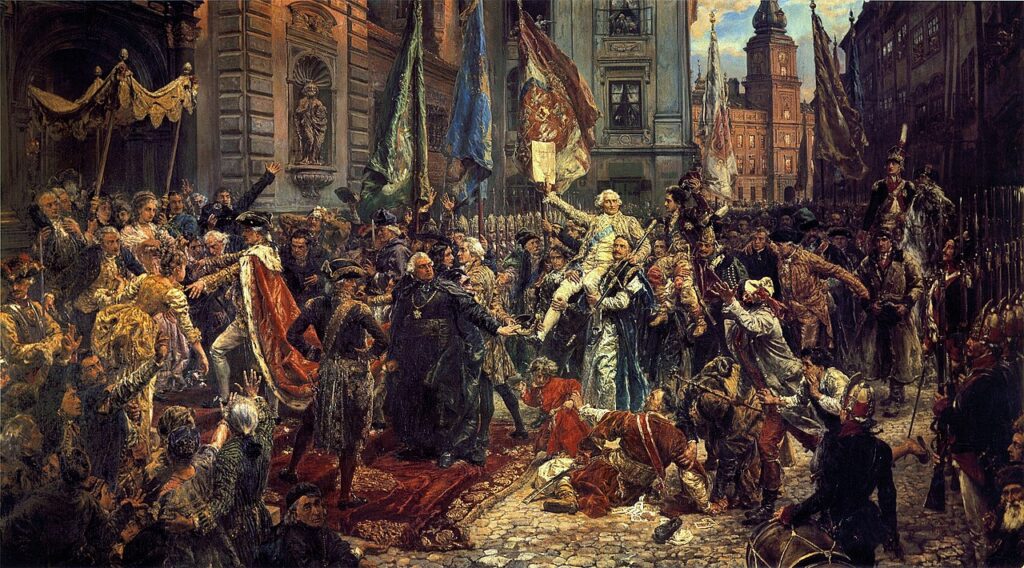
(Almost) everyone celebrates the adoption of an (almost) democratic constitution on May 3rd. Painted by Jan Matejko.
The final uprising
Both the new division and the peace conditions led to war-like uprisings across Poland and paved the ground for radical resistance movements. In 1994, a national uprising was declared under one of the veterans of the American Revolutionary War, Tadeusz Kosciuski. Initially, the Poles managed to regain territory from Russia, but they had so many soldiers at their disposal that the rebellion was put down in October 1794 with the help of Prussian and Austrian troops. In revenge, Russian troops executed a large number of Warsaw’s inhabitants. In 1795, Austria, Prussia and Russia agreed on the 3rd partition, which removed Poland from the map.
Divided between three powers, 1795 – 1918
Shortly after the partition of Poland, Napoleon stirred the pot across Europe and many Poles hoped that Napoleon would help re-establish the Polish state. When Napoleon announced an upcoming campaign against Russia, Poles volunteered in large numbers as soldiers. Even though Napoleon lost the war, sympathy for France persisted – and this feeling hasn’t completely disappeared yet. The current Polish national anthem is a war song with the chorus: March, march Dabrowski! – which refers to a group of Polish soldiers who fought on Napoleon’s side in various parts of Europe. In 1807, Napoleon created the Duchy of Warsaw, where he personally dictated the Constitution and instituted his own civil code – the Code Napoléon. This new state was confirmed by the Congress of Vienna in 1815, but it was renamed the Kingdom of Warsaw – and the Russian Tsar became king. The Congress of Vienna also negotiated a solution that established the independent city-state of “Cracow”, which would be jointly controlled by Austria, Prussia and Russia. The coming decades saw numerous uprisings against the occupying powers – primarily in the Kingdom of Warsaw. From having some autonomy in 1815, Warsaw gradually lost all signs of independence as the Tsar took care to Russify the area.
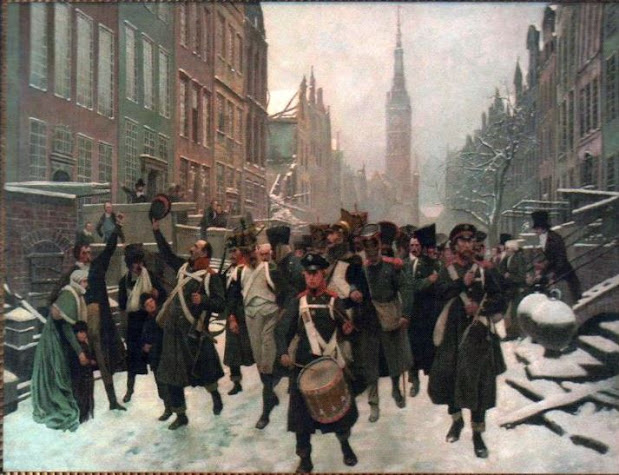
Napoleon’s troops march through Gdansk 1807
Poland on the outskirts
Thus, during the industrialisation of Europe, Poland belonged to three different states, all of which were located on the outskirts of their capitals – Berlin, Vienna and Moscow/Petersburg. Industrialisation in Poland was slow, but new industrial centres emerged, mainly around Lodz (textile industry) and Katowice (mining). At the same time, all the occupying states constructed new and extensive railway networks. However, inter-regional trade tariffs and differing laws caused the Poles in the three regions to drift apart from each other.
1. World War and independence 1919 – 1939
When World War I started in 1914, Poland became one of the most important battlefields in the war. Poles fought against other Poles in German, Austrian and Russian divisions. In the years before the war, a strong movement for independence or some kind of autonomy had emerged, and the struggle for Polish support led all the belligerent powers to guarantee some form of independence after the war. The former leader of the Socialist Party, Pilsudski, made his underground army available to Austria in the fight against Russia, but he was interned when he refused to fight against the Western powers later in the war. However, the three powers that had divided Poland emerged from World War I as losers, and it was therefore relatively easy for the Treaty of Versailles in June 1919 to guarantee the independent Polish state that Pilsudski had already proclaimed earlier. However, strong support from the US also played a crucial role. At the same time, Europe saw the re-establishment of a number of new countries, including Lithuania and Czechoslovakia, while the primarily German city of Gdansk gained the status of a self-governing free city. Poland gained access to the Baltic Sea through a corridor about 30 kilometres north of Gdansk.
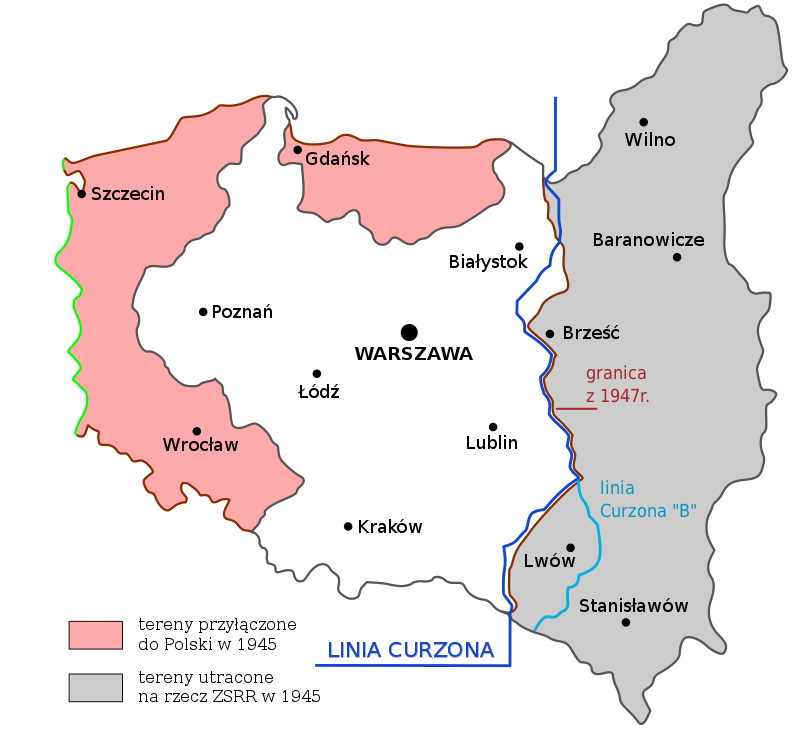
Poland – The grey area belonged to Poland after the peace treaty with Russia in 1921. This territory Poland lost to Poland after WWII. In return, Poland received the pink area from Germany.
New states in Europe and the definition of borders
The new Polish state initially struggled with neighbouring Czechoslovakia and Lithuania to define its borders, and also with Russia and Germany, where there was internal unrest. The war-weary Poles were therefore sent into a series of wars, the primary purpose of which was to fulfil Pilsudski’s dream of creating a multicultural Greater Poland. Wars against Lithuania and Russia incorporated Vilnius, Lyov and some Belarusian and Ukrainian territories into the new Poland. By the time the borders were finalised in 1922, Poland had become a state with 388,000 square kilometres and 27 million inhabitants, of which over 1/3 were ethnic minorities – there were 5 million Ukrainians and 2.5 million Jews who were not linguistically and culturally integrated into Polish society.
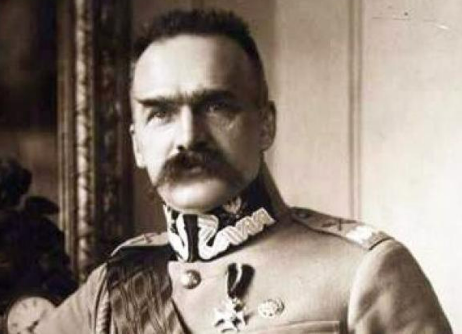
Piłsudski
Poland between the two world wars – Hyperinflation and unemployment
The new Poland was destroyed by wars, the infrastructure was shattered, and what was left didn’t fit the new geography. In addition, the country was short of money, hyperinflation was rampant and the country had unfriendly neighbours. It was also not possible to introduce a unified legal system in the new Poland overnight, so legal practices and customs differed in different parts of the country depending on which power they had previously belonged to. Unemployment was rampant and despite a coastline on the Baltic Sea, the country had no harbour city. But there was an amazing belief in the future.
The construction of the harbour city of Gdynia
In 1927, the establishment of Gdynia began north of Gdansk. Although Poland had international guarantees, that they could use the harbour in Gdansk, the predominantly pro-German government made it difficult for the Poles. At the same time, agricultural reforms were initiated, with large areas of land being subdivided and new legislation was introduced to protect workers in industry. However, the crisis was raging in Western Europe and it was virtually impossible to create a functioning state under the prevailing conditions. This contributed to the interwar period being characterised by political violence, strikes, inter-ethnic fighting and total chaos.

Gdynia – the port to the rest of the world
The 1926 coup
The democratic Marshal Pilsudski was so disheartened by the uncooperative parliament that he led a coup in 1926, after which he played an almost dictatorial role in the country until his death in 1935. After Pilsudski’s death, the turn towards a totalitarian state continued and ethnic tensions intensified.
However, the 1926 coup provided some stability and therefore managed to attract foreign capital for some industrialisation of the country; a low exchange rate also began to have a beneficial effect on exports. However, the Wall Street Crash of 1929 was a major blow to Poland. From 1933, the economy was even more top-down than before, and within a few years the state took over actual control of business
Second World War 1939 – 1945
In March 1939, Germany demanded, among other things, a corridor through Polish territory to the free city of Gdansk, which Hitler intended to fully incorporate into Greater Germany and which was adjacent to German East Prussia. In response to the demand, the UK and France provided a number of guarantees to Poland. Germany’s invasion of Poland in September 1939 marked the start of WWII. After a few weeks of war, western and central Poland came under German control. Then – in accordance with a secret agreement with Germany – the Soviet Union mobilised its troops and incorporated eastern Poland into the Soviet Union. In Polish historiography, this is often referred to as the 4th division. However, it should be remembered that of the 13 million Polish citizens who were incorporated into the Soviet Union, probably no more than 5 million could be considered ethnic Poles.
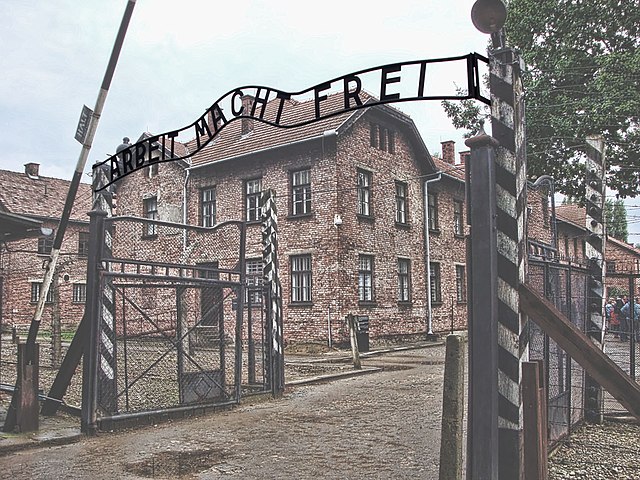
Poland became filled with Nazi extermination camps
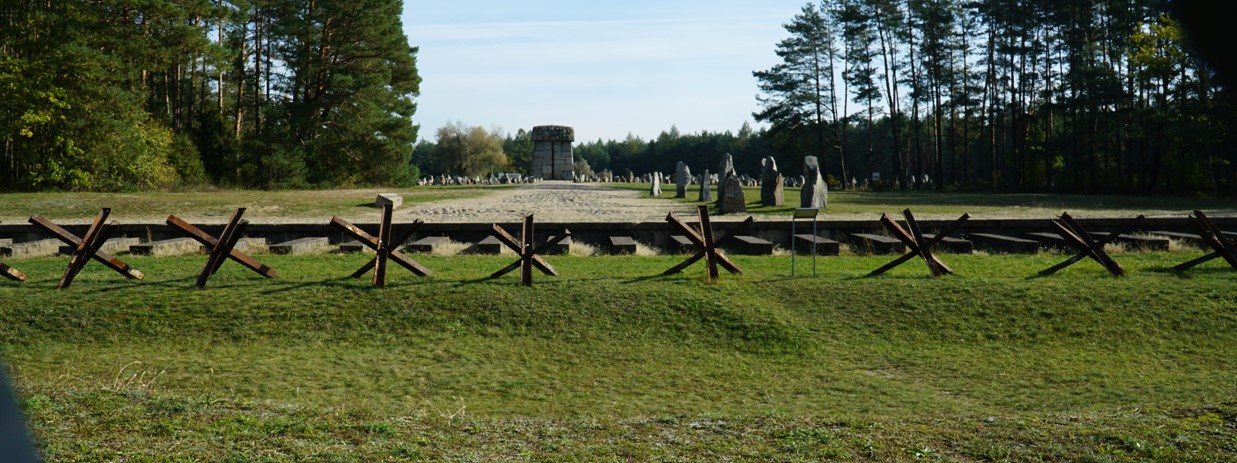
Treblinka – nazi extermination camp
Trip no. 24 – 5 timer. Price 850 zloty – A trip to the Nazi extermination camp Treblinka about 100 kilometres from Warsaw. Click on the headline to red more.
Stalinist repression
The Soviet Union carried out a thorough ethnic cleansing and large numbers of Poles were relocated to places like Siberia. Later, Germany set up concentration camps in Poland and carried out a systematic extermination of the Jewish population. The war also caused enormous damage in Poland. Apart from Krakow, Lodz and Poznan, which emerged from the war relatively unscathed, the destruction rate in all major Polish cities was over 40 per cent – virtually no buildings were intact. From January to March 1945, the Soviet Union occupied Poland as German troops were driven westwards. The People’s Army (a communist-dominated resistance movement) took control of Poland and refused to co-operate with the Polish government-in-exile in London. Following Stalin’s promises of free elections, the Western powers recognised the Soviet-backed government.
Poland as a Soviet puppet state 1945 – 1989
The end of World War II led to changes in a number of borders in Europe; for Poland, the result was that the Soviet annexation of Poland’s eastern territories was maintained, but the new Poland gained a large chunk of eastern Germany, including Gdansk, arguably half-Polish, and the purely German cities of Wroclaw and Szczecin. If you look at a map, you can see that Poland moved 250 kilometres to the west. The border change was accompanied by ethnic relocations, where ethnic Germans were sent to Germany. In return, the new Poland received ethnic Poles from the Soviet-occupied territories – and these arrived in large numbers to Gdansk, Wroclaw and Szczecin. Senior citizens in Wroclaw, for example, will usually be able to tell a story about how the family came from the now Ukrainian city of Lviv.
Fear of the Germans coming back
In the post-war period, there was a strong longing for the lost Polish cities of Lviv and Vilnius, and this can still be found in the older generation. Conversely, the settlers in the newly acquired (or in Polish – regained lands) German territories kept expecting that one day the Germans would be strong enough to come back and take what was rightfully theirs. This also meant that throughout the post-war period, Wroclaw and Szczecin did not receive the same level of investment as the rest of Poland. Jews who survived Nazi concentration camps often travelled to Israel or other Western countries, and Poland became one of the most ethnically pure nations in Europe.
Polish model of people’s democracy
After the war, a coalition government was formed under Soviet control. Stalin stood before the Western powers as a guarantor that Poland would hold democratic elections and that a new regime would emerge that lived up to democratic norms. The method was that Stalin forced a merger of parties and formed an anti-fascist coalition government, which the communists soon controlled. In the beginning, the administration was largely handled by the Red Army, who of course worked together with their friends in the communist resistance movement. The 1947 election resulted in communists and socialists jointly winning 85% of the seats in parliament, but there is no doubt that this result was achieved through electoral fraud. This allowed Stalin to maintain his influence in the country, and Poland declined to participate in the Marshall Plan. In 1948, a purge was carried out in the Communist Party, with the moderate General Secretary Gomulka thrown into prison and in 1949 a Russian general was appointed head of Poland’s armed forces.
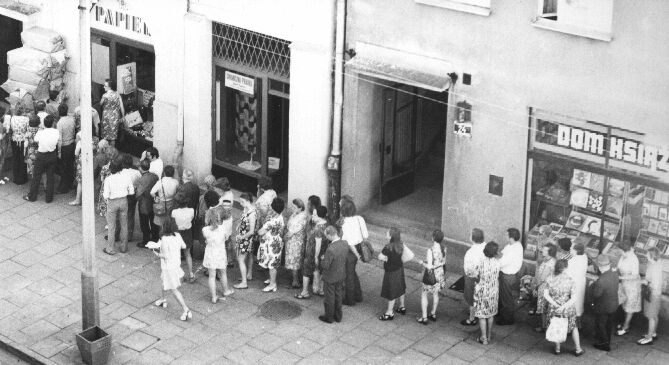
Long queues came to symbolise shopping in Poland under communism
With this, the takeover of Poland was effectively over, the Western powers gave up fighting for Central Europe and the Communist Party gained a de facto monopoly on power. It was initially a planned economy that emphasised heavy industry and de-prioritised the production of consumer goods. The political situation also meant that contact with Western Europe largely disappeared.
The country is being rebuilt
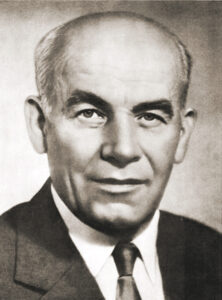
Wladyslaw Gomulka – Leader of the Communist Party and Poland 1956-1970
Stalin dies in 1953
Stalin died in 1953 and the iron grip on the Soviet Union’s satellite states loosened. In 1956, Gomulka, who had been deposed in 1948, took over the leadership of the Communist Party again after the death of Stalinist Bierut at a party congress in Russia. It had been tough years of rebuilding, but the 60s brought decent growth. Some decentralisation was allowed in the economy and certain export companies were allowed to plan their own activities. Small private businesses were allowed in communist Poland and always operated alongside the state economy. These small businesses could, to some extent, fulfil consumer demands for goods and services that the planned economy was unable to meet.
Rebellion in the East
Following reforms in Czechoslovakia, a student uprising occurred in Poland in 1968. It was immediately after the 1967 Six-Day War in the Middle East, where American military equipment won out over Soviet equipment – much to the displeasure of the Eastern Bloc. In Poland, an anti-Zionist campaign was established, officially turning the student uprising into a Zionist conspiracy. The few remaining Polish Jews were harassed into leaving Poland. The campaign sparked a wave of emigration to Western Europe and Israel.
The Warsaw Pact
In August 1969, the Soviet Union and Central Europe joined forces in the Eastern Bloc’s answer to NATO – the Warsaw Pact, which invaded Czechoslovakia later that year. Thus, the hope for reforms in Eastern Europe disappeared and the Soviet Union made it clear that it would not accept deviations from the common course.
Answer to NATO
In August 1969, the Soviet Union and Central Europe joined forces in the Eastern Bloc’s answer to NATO – the Warsaw Pact, which invaded Czechoslovakia later that year. Thus, the hope for reforms in Eastern Europe disappeared and the Soviet Union made it clear that it would not accept deviations from the common course.
Investments in Poland from 1970
In the 60s, Western Europe showed fantastic economic growth that Central Europe and Poland were unable to match. In Poland in 1970 stagnation led to strikes and considerations as to the future. Gomulka was deposed in 1970 after the military was deployed against striking workers. He was replaced by Gierek, who, with the blessing of the Soviet Union, opened up political, economic and trade relations with the West. Poland borrowed a lot of money and invested large sums in modernising its production apparatus and infrastructure. This led to a few years of tremendous growth in Poland, new apartments and infrastructure were created and industry was modernised. However, the money came too quickly and it was difficult to turn the huge sums into effective investments, which also fuelled corruption. Borrowing in Western currencies also put severe pressure on foreign exchange earnings and led to Poland going into de facto suspension of payments in the 1980s. The loans were partially cancelled after 1989, but Poland continued to pay off the remaining part well into the new millennium.
The military against workers
The military’s intervention in the 1970 strikes hung like a shadow over Poland, and the country was characterised by unrest throughout the mid-1970s. The unrest was often initiated among workers who were used to having a privileged position – miners and shipyard workers – who had special luxury shops and salaries that exceeded even high-ranking intellectual workers.
Elections and free trade unions
In 1980, there were “elections” for parliament in Poland, and the Communist Party and its supporting parties received 99.9% of the votes. In the same year – just before Christmas – the country was hit by major food price increases. It was an imbalance where the population believed that the state should be able to provide more goods than it had available. The price increases sparked anger and nationwide strikes, which started at the Gdansk Shipyard with the participation of the independent trade union Solidarity. Within a few months, Solidarity gained 9 million members.
Pressure from Moskow
The communist authorities were struggling to deal with the situation and were also under pressure from Moscow. As a result, Solidarity was legalised in an attempt to include them in the government and give them responsibility for what was happening. However, strikes, unrest and pressure from Moscow continued, and in December 1980, large-scale military exercises were carried out on the border with Poland. It’s a clear threat of military intervention, with then US President Jimmy Carter engaging in an attempt to stop any military intervention.
Polish Pope in Rome and Gorbachev in Moscow
There were probably two events in the 1980s that were crucial to Poland’s development in those years. One was Gorbachev’s takeover of the leadership of the Soviet Union (1985). Gorbachev relaxed ideological demands and tried to implement economic reforms. The second event was the election of Karol Wojtyla as Pope in 1978. It gave Poles a sense of international significance and gave them the courage to stand up to the political system. It was also significant that the Pope could not really be prohibited from travelling around Poland with sermons in which he spoke of “change”.
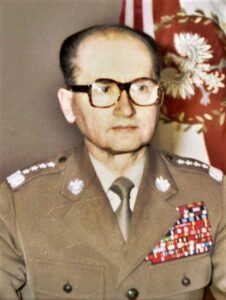
General Jaruzelski
Military dictatorship from 1981
In February 1981, General Jaruzelski took over as Head of Government. Although Jaruzelski was a good communist, he was more of a soldier. After a series of new unrest, Jaruzelski imposed martial law in December that year, banning Solidarity and ordering internment of the opposition.
The state of emergency lasted until 1983 when the Pope visited the country. The Polish population showed overwhelming enthusiasm for the Polish-born Pope, and the authorities were forced to balance between the demands of the population and the threat of military intervention.
Reforms and the Round Table
Even after the state of emergency was lifted, Jaruzelski continued his policy, which was more akin to a military dictatorship. Gorbachev’s reform policy in the Soviet Union from 1985 was the basis for similar reforms in other Eastern Bloc countries and the threat of military intervention was eased. The late 1980s saw new strikes and renewed demands for reform in Poland at a time when the economy reached a new low.
Huge inflation and economic chaos made the government decide to give Solidarity a share of the responsibility for the changes that everyone agreed were necessary. The board negotiated with Solidarity’s leadership in Roundtable Talks that were broadcast live on TV. Solidarity was legalised again and free parliamentary elections with secret ballots were agreed. The communists conditioned themselves to 2/3 of the seats in the lower house (Sejm), while the elections for the newly created upper house (Senate) were to be completely free.
Please send an email to m@hardenfelt.pl if you would like an English-speaking tour guide to show you the most important places in Warsaw.
